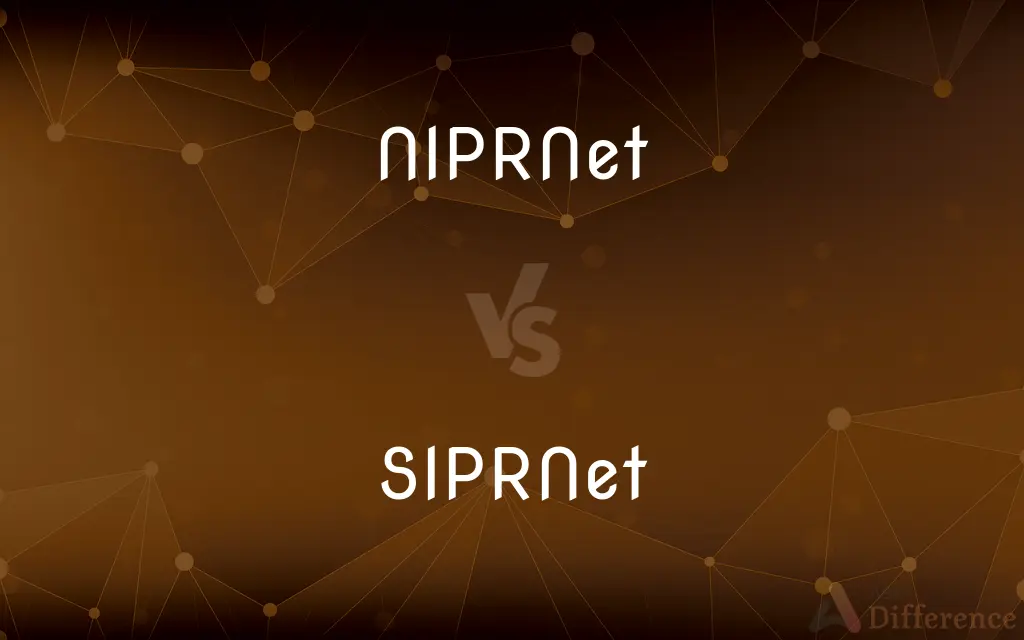NIPRNet vs. SIPRNet — What's the Difference?
By Tayyaba Rehman — Published on January 27, 2024
NIPRNet (Non-classified Internet Protocol Router Network) is used for exchanging unclassified but sensitive U.S. government information. SIPRNet (Secret Internet Protocol Router Network), transmitting classified information up to the secret level.

Difference Between NIPRNet and SIPRNet
Table of Contents
ADVERTISEMENT
Key Differences
NIPRNet: NIPRNet is a global network used by the U.S. Department of Defense and its supporting agencies for transmitting unclassified but sensitive information. SIPRNet: SIPRNet, also maintained by the U.S. Department of Defense, is used for transmitting classified information securely.
NIPRNet: Access to NIPRNet does not require top-level security clearances as the information is unclassified, but still sensitive. SIPRNet: Access to SIPRNet requires specific security clearances, as it handles classified information up to the secret level.
NIPRNet: NIPRNet is more accessible within the military and government networks for routine communication and operations. SIPRNet: SIPRNet is restricted to authorized personnel engaged in classified operations or communications, ensuring higher security.
NIPRNet: The security measures on NIPRNet, while robust, are less stringent compared to SIPRNet due to the nature of the information transmitted. SIPRNet: SIPRNet employs advanced security protocols and encryption to protect sensitive national security information.
NIPRNet: NIPRNet is often used for day-to-day communications within the military and government that require a level of security but not classification. SIPRNet: SIPRNet is essential for securely transmitting operationally critical and classified information within and between government agencies.
ADVERTISEMENT
Comparison Chart
Information Type
Unclassified but sensitive
Classified up to secret level
Access Requirement
General access within military and government
Restricted to personnel with security clearance
Usage
Routine communication and operations
Secure transmission of classified information
Security Measures
Standard government-level security
Advanced security protocols and encryption
User Base
Broader within military and government
Limited to authorized users handling secret info
Compare with Definitions
NIPRNet
NIPRNet offers a secure platform for non-classified information sharing.
Our unit coordinates logistics through NIPRNet.
SIPRNet
It is a secure network for handling operationally critical information.
Intelligence reports are often transmitted via SIPRNet.
NIPRNet
It is accessible to a broad range of military and government personnel.
As a government employee, I use NIPRNet for daily communications.
SIPRNet
Access to SIPRNet requires specific security clearances.
After receiving my security clearance, I gained access to SIPRNet.
NIPRNet
NIPRNet is a secure network for transmitting unclassified but sensitive U.S. government information.
We sent the deployment schedules over NIPRNet.
SIPRNet
This network is limited to authorized government and military users.
Only personnel cleared for classified information can use SIPRNet for communication.
NIPRNet
This network is essential for routine operational communication within the U.S. Defense Department.
NIPRNet is crucial for our day-to-day operational planning.
SIPRNet
SIPRNet employs advanced security protocols to protect national security information.
SIPRNet's encryption ensures our classified communications remain confidential.
NIPRNet
NIPRNet provides a level of security suitable for sensitive but unclassified information.
We ensure sensitive data is transmitted securely via NIPRNet.
SIPRNet
SIPRNet is used for transmitting classified information up to the secret level.
Mission details were communicated over SIPRNet for security.
Common Curiosities
What kind of information is transmitted through SIPRNet?
SIPRNet is used for transmitting classified information up to the secret level.
Who can access NIPRNet?
NIPRNet can be accessed by a wide range of military and government personnel for routine communication.
What is NIPRNet primarily used for?
NIPRNet is used for transmitting unclassified but sensitive U.S. government and military information.
Can classified information be sent over NIPRNet?
No, classified information should not be sent over NIPRNet; it is meant for unclassified but sensitive information.
Are emails sent over SIPRNet encrypted?
Yes, emails and other communications sent over SIPRNet are encrypted for security.
What is the main difference in the user base of NIPRNet and SIPRNet?
NIPRNet has a broader user base within the military and government, while SIPRNet is limited to authorized personnel handling classified information.
How are NIPRNet and SIPRNet connected to the Internet?
Both NIPRNet and SIPRNet are separate from the public Internet, with controlled and secured access points.
What security clearance is needed for SIPRNet?
Access to SIPRNet requires specific security clearances, typically up to the secret level.
Is NIPRNet open to the public?
No, NIPRNet is not open to the public; it is restricted to authorized military and government users.
How secure is SIPRNet compared to NIPRNet?
SIPRNet employs more advanced security protocols and encryption compared to NIPRNet, due to the higher classification of information it handles.
Is NIPRNet used for everyday military operations?
Yes, NIPRNet is commonly used for day-to-day communications and operations in the military and government sectors.
Are NIPRNet and SIPRNet used internationally by U.S. forces?
Yes, both NIPRNet and SIPRNet are used internationally by U.S. forces for secure communication and information sharing.
Can someone access SIPRNet from a personal computer?
No, access to SIPRNet is restricted and cannot be done from personal computers; it requires specific secure terminals.
What type of training is required to use SIPRNet?
Users typically require specialized training and security briefings to access and use SIPRNet.
Can information from SIPRNet be transferred to NIPRNet?
No, transferring information from SIPRNet to NIPRNet is not allowed due to the difference in classification levels.
Share Your Discovery

Previous Comparison
Adipex vs. Adderall
Next Comparison
High Rise Jeans vs. Mom JeansAuthor Spotlight
Written by
Tayyaba RehmanTayyaba Rehman is a distinguished writer, currently serving as a primary contributor to askdifference.com. As a researcher in semantics and etymology, Tayyaba's passion for the complexity of languages and their distinctions has found a perfect home on the platform. Tayyaba delves into the intricacies of language, distinguishing between commonly confused words and phrases, thereby providing clarity for readers worldwide.














































